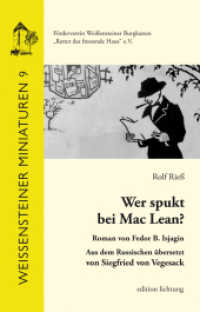Full Description
Historical performance research is undergoing a transformation as the research from different centers intersects in new ways. Practice in Context reflects this vibrant, diverse, and evolving field.
The Historically Informed Performance --shorted to HIP-- movement first dipped its toe into the nineteenth century by tackling the symphonies of Beethoven in the nineteen eighties. Since then, there has been a burgeoning of performances and recordings of nineteenth- and early twentieth-century repertoire on period instruments. But the advance of HIP into post-Classical repertoires has exposed the specific challenges nineteenth-century historical performance styles present to a 'period' movement that is characterised by crisp, clean, light playing. Historically evidenced nineteenth-century style remains elusive to many professional performers even after four decades of marketing 'period' performances of this repertoire. A real transformation of professional post-Classical HIP will only be possible if scholars and performers start to find new ways to inter-relate, which is central to the work of many of the contributors to this book. Editors Claire Holden, Eric F. Clarke, and Cayenna Ponchione-Bailey have brought together a diverse group of international contributors to present different perspectives and offer new possibilities to performers, scholars, and scholar-performers.
The book addresses a diverse range of pressing and exciting topics in nineteenth-century historically informed practices, focusing on new kinds of research that move away from traditional treatise archaeology. These include multi-disciplinary approaches, such as the use of empirical methods in the study of present-day HIP performance practices, and increased contextualisation through a closer relationship with cultural and social musicology. Practice in Context brings together scholars and performer/scholars who are interested in how historical research can contribute to greater understanding of the musical priorities and artistic decision-making processes when performing nineteenth-century pieces.
Contents
1: George Kennaway: Nineteenth-Century Musicalities in the Twenty-First Century
2: Christina Bashford: Staging Chamber Music: Towards New Intersections of Performance Practice and Concert History
3: Mary Hunter: How Special Is Nineteenth-Century Performance Practice?
4: Marten Noorduin: The Rehearsal Practices of the London Philharmonic in the Early to Mid-Nineteenth Century
5: Trevor Herbert: Bands as Musical Subcultures: Cultures, Practices and Influences
6: David Milsom: String Sonority in the Nineteenth and Early Twentieth Centuries
7: Anna Scott: To Change One's Skin According to the Music at Hand: Locating the Transformative Power of Recordings-Informed Performance
8: Emily Worthington: HIP, Embodied Knowledge, and the Practice of Harmoniemusik
9: Neal Peres Da Costa: Concepts of Beautiful in Nineteenth-Century Musical Performance: Reinvigorating Artistic Personality and Spontaneous Creativity
10: Claire Holden: 'The Liberty to "Sing" to Their Heart's Content': Principles and Practices of Ensemble in Nineteenth-Century Orchestral String Sections
11: Eric F. Clarke and Cayenna Ponchione-Bailey: String Sound in the Round: Methods, Outcomes, and Implications of Experimental Approaches to Nineteenth-Century String Playing








